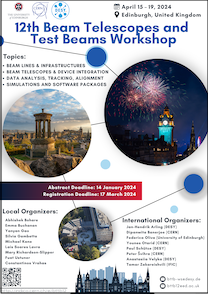Speaker
Description
A beam telescope based on the Timepix4 ASIC was built in order to perform tests of synchronous multiple-detector readout and track reconstruction with fast timing capability.
The telescope consists of eight planes with n-on-p silicon sensors, each bump bonded to a Timepix4 ASIC. Four of these planes are instrumented with 300 µm thick planar sensors, and they are tilted with respect to the be incidence to provide high quality spatial measurements. The other four planes have 100 µm thick sensors to achieve a better time response.
The Timepix4 is designed to record both the time of arrival (ToA) and the time over threshold (ToT) for each discriminated signal. It has a 448 × 512 pixel matrix with square pixels at a 55 μm pitch. Each superpixel, a group of two by four pixels, has a 640 MHz voltage controlled oscillator (VCO). The VCO has four phase shifted copies, which results in a ToA digitisation with time bins of 195 ps. The ToT is proportional to the charge collected by the silicon sensor, and is used to improve spatial resolution based on charge sharing. The ToT is also used to correct for timewalk and improve the ToA resolution. After VCO and timewalk corrections the timing resolution of each plane improves significantly. The measurements can be combined to achieve a more precise time stamp on a track. In this presentation a detailed overview of the most recent results in temporal and spatial resolutions obtained by the telescope will be shown.
